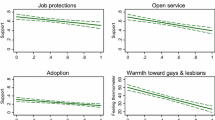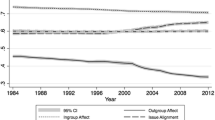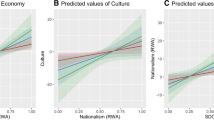Abstract
Previous research has suggested that disgust is associated with conservative political attitudes (Cognit Emot, 23:714–725 by Inbar et al. 2009). The present research evaluated whether disgust can also lead to more liberal attitudes, due to its relation to fairness-related violations. Across three studies, we demonstrated that inducing feelings of disgust lead participants to adopt more left-wing political attitudes with regard to economic issues. In Study 1, participants induced to experience disgust by looking at four photographs reported more left-wing economic attitudes than participants who were exposed to sadness-inducing images. In Study 2, the same effect was observed but only for participants who had greater sensitivity to their bodily sensations. Study 3 replicated Studies 1–2 and also showed that besides economic attitudes, participants’ general political orientation was also shifted toward the liberal spectrum by a disgust induction. Taken together, these results provide evidence for a relationship between feelings of disgust and the endorsement of equality-promoting political attitudes. Our results, therefore, provide a different perspectives on disgust and the first evidence that it can also lead people to adopt more liberal attitudes on economic issues.


Similar content being viewed by others
Notes
The IAPS numbers for the pictures used in the disgust condition were: 9301 (toilet), 9302 (toilet), 9322 (vomit), and 9325 (vomit). For the sadness condition the following pictures were used: 2205 (hospital), 2276 (crying girl), 6838 (police), and 9184 (injured dog).
References
Aiken, L. S., & West, S. G. (1991). Testing and interpreting interactions in multiple regression. Newbury Park: Sage Publications.
Anderson, A. K., Christoff, K., Panitz, D., De Rosa, E., & Gabrieli, J. D. (2003). Neural correlates of the automatic processing of threat facial signals. Journal of Neuroscience, 23, 5627–5633.
Calder, A. J., Beaver, J. D., Davis, M. H., van Ditzhuijzen, J., Keane, J., & Lawrence, A. D. (2007). Disgust sensitivity predicts the insula and pallidal response to pictures of disgusting foods. European Journal of Neuroscience, 25, 3422–3428.
Chapman, H. A., Kim, D. A., Susskind, J. M., & Anderson, A. K. (2009). In bad taste: Evidence for the oral origins of moral disgust. Science, 323, 1222–1225.
Damasio, A. R. (1994). Descartes’ error: Emotion, reason, and the human brain. New York: Putnam.
Damasio, A. R. (1995). On some functions of the human prefrontal cortex. Annals of the New York Academy of Sciences, 769, 241–252.
Dollinger, S. J. (2007). Creativity and conservatism. Personality and Individual Differences, 43, 1025–1035.
Dunlap, W., & Kemery, E. (1987). Failure to detect moderating effects—is multicollinearity the problem? Psychological Bulletin, 102, 418–420.
Evans, G., Heath, A., & Lalljee, M. (1996). Measuring left-right and libertarian-authoritarian values in the British electorate. The British Journal of Sociology, 47, 93–112.
Goldberg, L. R., Johnson, J. A., Eber, H. W., Hogan, R., Ashton, M. C., Cloninger, C. R., et al. (2006). The International Personality Item Pool and the future of public-domain personality measures. Journal of Research in Personality, 40, 84–96.
Graham, J., Haidt, J., & Nosek, B. A. (2009). Liberals and conservatives rely on different sets of moral foundations. Journal of Personality and Social Psychology, 96, 1029–1046.
Graham, J., Nosek, B. A., Haidt, J., Iyer, R., Koleva, S., & Ditto, P. H. (2011). Mapping the moral domain. Journal of Personality and Social Psychology, 101, 366.
Haidt, J. (2001). The emotional dog and its rational tail: A social intuitionist approach to moral judgment. Psychological Review, 108, 814–834.
Haidt, J., & Joseph, C. (2004). Intuitive ethics: How innately prepared intuitions generate culturally variable virtues. Daedalus, 133, 55–66.
Haidt, J., Mccauley, C., & Rozin, P. (1994). Individual-differences in sensitivity to disgust—a scale sampling 7 domains of disgust elicitors. Personality and Individual Differences, 16, 701–713.
Haidt, J., Rozin, P., Mccauley, C., & Imada, S. (1997). Body, psyche, and culture: The relationship between disgust and morality. Psychology & Developing Societies, 9, 107–131.
Helzer, E. G., & Pizarro, D. A. (2011). Dirty liberals! Reminders of physical cleanliness influence moral and political attitudes. Psychological Science, 22(4), 517–522.
Henningham, J. (1996). A 12-item scale of social conservatism. Personality and Individual Differences, 20, 517–519.
Herzog, H. A., & Golden, L. L. (2009). Moral emotions and social activism: The case of animal rights. Journal of Social Issues, 65, 485–498.
Hodson, G., & Costello, K. (2007). Interpersonal disgust, ideological orientations, and dehumanization as predictors of intergroup attitudes. Psychological Science, 18, 691–698.
Horberg, E. J., Oveis, C., Keltner, D., & Cohen, A. B. (2009). Disgust and the moralization of purity. Journal of Personality and Social Psychology, 97, 963–976.
Inbar, Y., Pizarro, D. A., & Bloom, P. (2009a). Conservatives are more easily disgusted than liberals. Cognition and Emotion, 23, 714–725.
Inbar, Y., Pizarro, D. A., & Bloom, P. (2012). Disgusting smells cause decreased liking of gay men. Emotion, 12, 23–27.
Inbar, Y., Pizarro, D., Iyer, R., & Haidt, J. (2012). Disgust sensitivity, political conservatism, and voting. Social Psychological and Personality Science, 3, 537–544.
Inbar, Y., Pizarro, D. A., Knobe, J., & Bloom, P. (2009b). Disgust sensitivity predicts intuitive disapproval of gays. Emotion, 9, 435–439.
Jamison, W. V., & Lunch, W. M. (1992). Rights of animals, perceptions of science, and political activism: Profile of American animal rights activists. Science, Technology and Human Values, 17, 438–458.
Jost, J. T., Glaser, J., Kruglanski, A. W., & Sulloway, F. J. (2003). Political conservatism as motivated social cognition. Psychological Bulletin, 129, 339–375.
Keltner, D., Ellsworth, P. C., & Edwards, K. (1993). Beyond simple pessimism: Effects of sadness and anger on social perception. Journal of Personality and Social Psychology, 64, 740–752.
Keltner, D., & Lerner, E. J. (2010). Emotion. In S. T. Fiske, D. T. Gilbert, & G. Lindzey (Eds.), Handbook of social psychology (pp. 317–352). New Jersey: John Wiley & Sons.
Laird, J. D. (1984). The real role of facial response in the experience of emotion: A reply to Tourangeau and Ellsworth, and others. Journal of Personality and Social Psychology, 47, 909–917.
Laird, J. D., Alibozak, T., Davainis, D., Deignan, K., Fontanella, K., et al. (1994). Individual differences in the effects of spontaneous mimicry on emotional contagion. Motivation and Emotion, 18, 231–247.
Lang, P.J., Bradley, M.M., & Cuthbert, B.N. (2008). International affective picture system (IAPS): Affective ratings of pictures and instruction manual. Technical Report A-8. University of Florida, Gainesville, FL.
Lerner, J., & Keltner, D. (2000). Beyond valence: Toward a model of emotion-specific influences on judgement and choice. Cognition and Emotion, 14, 473–493.
Maltby, J. (1997). The concurrent validity of a short measure of social conservatism among English students. Personality and Individual Differences, 23, 901–903.
Miller, L. C., Murphy, R., & Buss, A. H. (1981). Consciousness of body: Private and public. Journal of Personality and Social Psychology, 41, 397–406.
Moretti, L., & Di Pellegrino, G. (2010). Disgust selectively modulates reciprocal fairness in economic interactions. Emotion, 10, 169–180.
Nussbaum, M. C. (2004). Hiding from humanity: Disgust, shame, and the law. Princeton, NJ: Princeton University Press.
Olatunji, B. O. (2008). Disgust, scrupulosity and conservative attitudes about sex: Evidence for a mediational model of homophobia. Journal of Research in Personality, 42, 1364–1369.
Olatunji, B. O., Williams, N. L., Tolin, D. F., Abramowitz, J. S., Sawchuk, C. N., Lohr, J. M., et al. (2007). The disgust scale: Item analysis, factor structure, and suggestions for refinement. Psychological Assessment, 19, 281–297.
Rozin, P., Haidt, J., & Fincher, K. (2009). From oral to moral. Science, 323, 1179–1180.
Rozin, P., Haidt, J., & McCauley, C. R. (2008). Disgust. In M. Lewis, J. M. Haviland-Jones, & L. F. Barrett (Eds.), Handbook of emotions (3rd ed., pp. 757–776). New York: Guilford Press.
Rozin, P., Haidt, J., McCauley, C., Dunlop, L., & Ashmore, M. (1999). Individual differences in disgust sensitivity: Comparisons and evaluations of paper-and-pencil versus behavioural measures. Journal of Research in Personality, 33, 330–351.
Rozin, P., Markwith, M., & Stoess, C. (1997). Moralization and becoming a vegetarian: The transformation of preferences into values and the recruitment of disgust. Psychological Science, 8, 67–73.
Ruby, M. B. (2012). Vegetarianism. A blossoming field of study. Appetite, 58, 141–150.
Sanfey, A., Rilling, J., Aronson, J., Nystrom, L., & Cohen, J. (2003). The neural basis of economic decision-making in the ultimatum game. Science, 300, 1755–1758.
Schlenker, B. R., Chambers, J. R., & Le, B. M. (2012). Conservatives are happier than liberals, but why? Political ideology, personality, and life satisfaction. Journal of Research in Personality, 46, 127–146.
Schnall, S., Abrahamson, A., & Laird, J. D. (2002). Premenstrual syndrome and misattribution: A self-perception, individual differences perspective. Basic and Applied Social Psychology, 24, 215–228.
Schnall, S., Haidt, J., Clore, G. L., & Jordan, A. H. (2008). Disgust as embodied moral judgment. Personality and Social Psychology Bulletin, 34, 1096–1109.
Schwarz, N., & Clore, G. (1983). Mood, misattribution, and judgments of well-being—informative and directive functions of affective states. Journal of Personality and Social Psychology, 45, 513–523.
Shaver, P., Schwartz, J., Kirson, D., & O’Connor, C. (1987). Emotion knowledge—further exploration of a prototype approach. Journal of Personality and Social Psychology, 52, 1061–1086.
Smith, K. B., Oxley, D., Hibbing, M. V., Alford, J. R., & Hibbing, J. R. (2011). Disgust sensitivity and the neurophysiology of left-right political orientations. PLoS ONE, 6, 1–9.
Terrizzi, J. A, Jr, Shook, N. J., & McDaniel, M. A. (2013). The behavioral immune system and social conservatism: A meta-analysis. Evolution and Human Behavior, 34(2), 99–108.
Terrizzi, J. A, Jr, Shook, N. J., & Ventis, W. L. (2010). Disgust: A predictor of social conservatism and prejudicial attitudes toward homosexuals. Personality and Individual Differences, 49, 587–592.
Tybur, J. M., Merriman, L. A., Hooper, A. E. C., McDonald, M. M., & Navarrete, C. D. (2010). Extending the behavioural immune system to political psychology: Are political conservatism and disgust sensitivity really related? Evolutionary Psychology, 8, 599–616.
Vartanian, L. R. (2010). Disgust and perceived control in attitudes towards obese people. International Journal of Obesity, 34, 1302–1307.
Wheatley, T., & Haidt, J. (2005). Hypnotic disgust makes moral judgments more severe. Psychological Science, 16, 780–784.
Wicker, B., Keysers, C., Plailly, J., Royet, J., Gallese, V., & Rizzolatti, G. (2003). Both of us disgusted in my insula: The common neural basis of seeing and feeling disgust. Neuron, 40, 655–664.
Wilson, G. D., & Patterso, J. R. (1968). A new measure of conservatism. British Journal of Social and Clinical Psychology, 7, 264–269.
Wright, P., He, G., Shapira, N. A., Goodman, W. K., & Liu, Y. (2004). Disgust and the insula: fMRI responses to pictures of mutilation and contamination. Neuroreport, 15, 2347–2351.
Acknowledgments
The authors acknowledge funding support from Romanian-American Foundation, Dinu Patriciu Foundation, Ratiu Foundation, and Christ Church (University of Oxford). We also acknowledge Nicholas Cooper, Jim Everett, Thomas Hocking, and Yiu Luke for assistance with participant recruitment and data collection.
Conflict of interest
The authors declare no conflict of interest.
Author information
Authors and Affiliations
Corresponding author
Rights and permissions
About this article
Cite this article
Petrescu, D.C., Parkinson, B. Incidental Disgust Increases Adherence to Left-Wing Economic Attitudes. Soc Just Res 27, 464–486 (2014). https://doi.org/10.1007/s11211-014-0221-7
Published:
Issue Date:
DOI: https://doi.org/10.1007/s11211-014-0221-7




